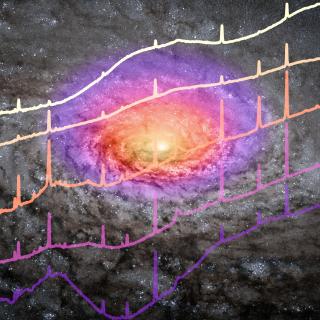It may interest you
-
 An international team led by Cristina Ramos Almeida, a researcher at the Instituto de Astrofísica de Canarias (IAC), has used the James Webb Space Telescope (JWST) to observe five dust-obscured quasars — and the results offer new insights into how galaxies and their central supermassive black holes may evolve. The study is published today in the journal Astronomy & Astrophysics . The energy released by supermassive black holes at the centres of galaxies is a fundamental ingredient in regulating the formation of new stars, and thus galaxy growth. This occurs during an active phase, usuallyAdvertised on
An international team led by Cristina Ramos Almeida, a researcher at the Instituto de Astrofísica de Canarias (IAC), has used the James Webb Space Telescope (JWST) to observe five dust-obscured quasars — and the results offer new insights into how galaxies and their central supermassive black holes may evolve. The study is published today in the journal Astronomy & Astrophysics . The energy released by supermassive black holes at the centres of galaxies is a fundamental ingredient in regulating the formation of new stars, and thus galaxy growth. This occurs during an active phase, usuallyAdvertised on -
 Científicos del IAC publican en Nature Astronomy una guía práctica para mejorar propuestas y solicitudesAdvertised on
Científicos del IAC publican en Nature Astronomy una guía práctica para mejorar propuestas y solicitudesAdvertised on -
 Cristina Ramos Almeida, investigadora del Instituto Astrofísico de Canarias (IAC) y coautora de más de un centenar de artículos sobre galaxias y agujeros negros, ha sido una de las homenajeadas en la primera edición de los premios "Mujeres tenían que SER" de Radio Club Tenerife, Cadena SER. El evento, celebrado en la noche del miércoles 29 de octubre, en la sala Adán Martín del edificio de Presidencia del Gobierno en Santa Cruz de Tenerife, ha teñido el espacio de reconocimiento al talento femenino en diversos ámbitos. La distinción resalta la crucial contribución de Ramos Almeida a laAdvertised on
Cristina Ramos Almeida, investigadora del Instituto Astrofísico de Canarias (IAC) y coautora de más de un centenar de artículos sobre galaxias y agujeros negros, ha sido una de las homenajeadas en la primera edición de los premios "Mujeres tenían que SER" de Radio Club Tenerife, Cadena SER. El evento, celebrado en la noche del miércoles 29 de octubre, en la sala Adán Martín del edificio de Presidencia del Gobierno en Santa Cruz de Tenerife, ha teñido el espacio de reconocimiento al talento femenino en diversos ámbitos. La distinción resalta la crucial contribución de Ramos Almeida a laAdvertised on